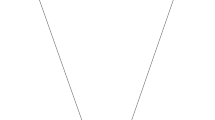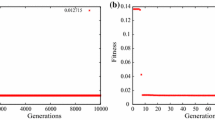Abstract
As a comparatively new developed stochastic method — Particle Swarm Optimization (PSO), it is widely applied to various kinds of optimization problems especially of nonlinear, non-differentiable or non-concave types. In this paper, a Parallel Modified Guaranteed Converged Particle Swarm algorithm (PMGCPSO) is proposed, which is inspired by the Guaranteed Converged Particle Swarm algorithm (GCPSO) proposed by von den Bergh. Details in the algorithm implementation and properties are presented and, an analytical benchmark test and structural sizing and topological test cases are used to evaluate the performance of the proposed PSO variant, PMGCPSO exhibited competitive performance due to improved global searching ability and its corresponding parallel model indicates nice parallel efficiency.
Similar content being viewed by others
References
Alatas, B., Akin, E., and Ozer, A. B. (2009). “Chaos embedded particle swarm optimization algorithms.” Chaos, Solitons & Fractals, Vol. 40, No. 4, pp. 1715–1734.
Angeline, P. J. (1998). “Evolutionary optimization versus particle swarm optimization: Philosophy and performance differences.” Evolutionary Programming VII, Springer, Berlin, Heidelberg, Germany, pp. 601–610.
Bochenek, B. and Foryś, P. (2006). “Structural optimization for post-buckling behavior using particle swarms.” Structural and Multidisciplinary Optimization, Vol. 32, No. 6, pp. 521–531.
Chen, M. R., Li, X., Zhang, X., and Lu, Y. Z. (2010). “A novel particle swarm optimizer hybridized with extremal optimization.” Journal of Applied Soft Computing, Vol. 10,Issue 2, pp. 367–373.
Chen, M. R., Lu, Y. Z., and Yang, G. (2006). “Population-based extremal optimization with adaptive Lévy mutation for constrained optimization.” Proc. of International Conference on Computational Intelligence and Security, CIS 2006, Guangzhou, China, pp. 258–261.
Clerc, M. (1999). “The swarm and the queen: Towards a deterministic and adaptive particle swarm optimization.” Proc. of the Congress on Evolutionary Computation, IEEE, Vol. 3, pp. 1951–1957.
Clerc, M. and Kennedy, J. (2002). “The particle swarm: Explosion, stability and convergence in a multi-dimensional complex space.” Transactions on Evolutionary Computation, IEEE, Vol. 16, No.1, pp. 58–73.
Eberhart, R. and Kennedy, J. (1995). “A new optimizer using particle swarm theory.” Proc. of the sixth International Symposium on Micro Machine and Human Science, Nagoya, Japan, Vol. 1, pp. 39–43.
Fiacco, A. V. and McCormick, G. P. (1990). Nonlinear programming: Sequential unconstrained minimization techniques, Classics in Applied Mathematics, No. 4, Society for Industrial Mathematics.
Fourie, P. C. and Groenwold, A. (2002). “The particle swarm optimization algorithm in size and shape optimization.” Structural and Multidisciplinary Optimization, Vol. 23, No. 4, pp. 259–267.
Hansen, N. and Kern, S. (2004). “Evaluating the CMA Evolution Strategy on Multimodal Test Functions.” Proc. of Eighth International Conference on Parallel Problem Solving from Nature PPSN VIII, Springer, Berlin, Heidelberg, Germany, pp. 282–291.
Kaoa, Y. T. and Zahara, E. (2008). “A hybrid genetic algorithm and particle swarm optimization for multimodal functions.” Applied Soft Computing, Vol. 8, No. 2, pp. 849–857.
Khan, M. R. (1984). “Optimality criterion techniques applied to frames having general cross-sectional relationships.” A/AA Journal, Vol. 22, No. 5, pp. 669–676.
Krink, T. and Løvbjerg, M. (2002). “The lifecycle model: Combining particle swarm optimisation, genetic algorithms and hillclimbers.” Proc. of Parallel Problem Solving from Nature VII, Springer, Berlin, Heidelberg, Germany, pp. 621–630.
Levitin, G., Hu, X. H., and Dai, Y. S. (2007). “Particle swarm optimization in Reliability Engineering.” Studies in Computational Intelligence, Vol. 40, pp. 83–112.
Løvberg, M., Rasmussen, T. and Krink, T. (2001). “Hybrid Particle Swarm Optimiser with Breeding and Subpopulation.” Proc. of the Third Genetic and Evolutionary Computation Conference, San Francisco, USA, Vol. 2001, pp. 469–476.
Pedersen, M. E. H. and Chipperfield, A. J. (2010). “Simplifying Particle Swarm Optimization.” Applied Soft Computing, Vol. 10, No. 2, pp. 618–628.
Poli, R. (2007). An analysis of publications on particle swarm optimization applications, Tech. Rep., CSM-469, Department of Computing and Electronic Systems, University of Essex, Colchester, Essex, UK.
Prez, R.E. and Behdinan, K. (2007). “Particle swarm approach for structural design optimization.” Computer & Structures, Vol. 85, Nos. 19–20, pp. 1579–1588.
Pulido, G. T. and Coello C. A. C. (2004). “A constraint-handling mechanism for particle swarm optimization.” Evolutionary Computation, IEEE, Vol. 2, pp. 1396–1403.
Rechenberg, R. (1973). Evolutionsstrategie: Optimierung technischer syseme nach prinzipien der biologischen evolution, Frommann-Holzboog, Stuttgart, Germany.
Sadek, E. A. (1992). “Optimization of structures having general crosssectional relationships using an optimality criterion method.” Computers & Structures, Vol. 43, No. 5, pp. 959–969.
Schutte, J. F., Reinbolt, J. A., Fregly, B. J., Haftka, R. T., and George, A. D. (2004). “Parallel Global Optimization with the Particle Swarm Algorithm.” Int. J. Numer. Meth. Engrg., Vol. 61,Issue 13, pp. 2296–2315.
Shelokar, P., Siarry, P., Jayaraman, V., and Kulkarni, B. (2007). “Particle swarm and ant colony algorithms hybridized for improved continuous optimization.” Applied Mathematics and Computation, Vol. 188, No. 1, pp. 129–142.
Shi, X. H., Liang, Y. C., Lee, H. P., Lu, C., and Wang, L. M. (2005). “An improved GA and a novel PSOGA-based hybrid algorithm.” Information Processing Letters, Vol. 93, No. 5, pp. 255–261.
Svanberg, K. (1984). “On local and global minima in structural optimization.” New Directions in Optimum Structural Design, Wiley, New York, pp. 327–341.
Venter, G. and Sobieszczanski-Sobieski, J. (2004). “Multidisciplinary optimization of a transport aircraft wing using particle swarm optimization.” Struct. Multidiscip. Optim., Vol. 26, Nos. 1–2, pp. 121–31.
Von den Bergh, Fan. (2001). An analysis of particle swarm optimizers, PhD Thesis, University of Pretoria, Pretoria, South Africa.
Wang, Q. and Arora, J. S. (2006). “Alternative equations for structural optimization: An evaluation using frames.” Structural Engineering, Vol. 132,Issue 12, pp. 1880–1889.
Wolpert, D. H. and Marceady, W. G. (1997). “No free lunch theorems for optimization.” IEEE Transactions on Evolutionary Computation, Vol. 1, No. 1, pp. 67–82.
Xie, X., Zhang, W., and Yang, W. (2002). “A dissipative particle swarm optimization.” Proc. of the 2002 Congress on Evolutionary Computation, Honolulu, Hawaii, USA, pp. 1456–1461.
Author information
Authors and Affiliations
Corresponding author
Rights and permissions
About this article
Cite this article
Yang, B., Bletzinger, KU., Zhang, Q. et al. Frame structural sizing and topological optimization via a parallel implementation of a modified particle Swarm algorithm. KSCE J Civ Eng 17, 1359–1370 (2013). https://doi.org/10.1007/s12205-013-0001-1
Received:
Revised:
Accepted:
Published:
Issue Date:
DOI: https://doi.org/10.1007/s12205-013-0001-1




